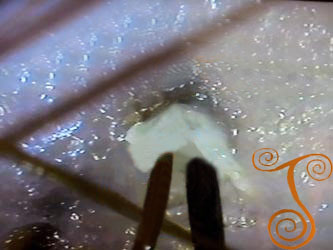Dandruff
Dry dandruff, greasy dandruffThe dry dandruff is caused by a fungus, called Pityrosporon – it always falls out from the hair. Thy symptoms can be seen by naked eyes too. With microcamera we can see the flat, greyish-white tabular plaques are fixed to the roots of hair. By rubbing the plaques, it rolls to a sausage shape. It tears down the fatty acid content of the hydrolipid layer, so the water gets free from the bondage, it evaporated, so the skin dries up. It also destructs proteins, which contain Tyrosin aminoacid, which is responsible for the colour of the skin – this is the reason, why the skin gets greyish. The problem can be treatet by antimicotic (anti-fungal) products, the duration of treatment is usually ~6 months.
The treatment of dry dandruff requires the products with light-blue colour-code. The agents of the hair bath are antiseptic, and the nettle (Urtica dioica) extract is very good against skin peeling. Moreover, it contains iceland moss (Cetraria islandica), and octopirox, which has perfect antimicotic effect.
In case of greasy dandruff, the guests tell us usually that the hair is greasy, the scalp is itchy, and by scratching the skin, a sticky material retains under the nails. In severe cases, hair loss can be associated with this micotic disorder.
Basicly, the greasy dandruff can not be seen by naked eyes (the guest does not complain of dandruff), this disorder is a bacterial infection, which is extremely infective (even by using an affected comb, or if the hair dresser does not sterilize his/her devices). This type of bacterial infection is very aggressive, so the treatment shoud be shorter than in case of a dry dandruff (3-6 months), but it is much more intensive.
It is caused by the Pityrosporum Acne bacterium, which is highly intractable, it has a strong cell wall. It produces an enzyme, called lipaze, which annihilates the suet, the proportion of free fatty acids increases with 30-40 %.
By using the microcamera, we can see yellow drop-shaped suet-balls, which are sitting at the roots of the hair. By examinig the hair bulb, it can be clearly detected that the bulb is totally destoyed by the bacterium.
The treatment requires the products with dark-blue colour-code. In this case the role of the iceland moss (Cetraria islandica) is also emphasized, because it is a natural antibioticum.
